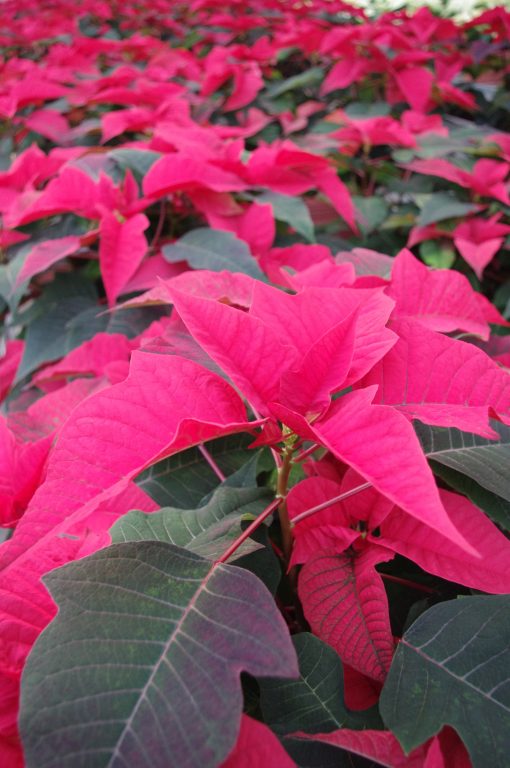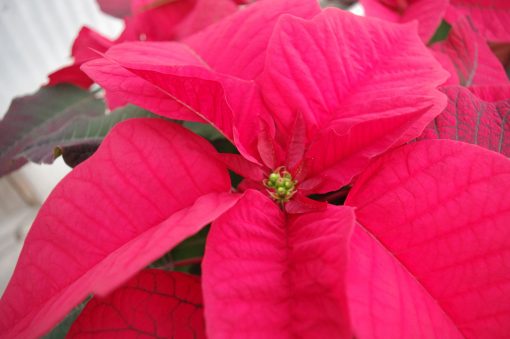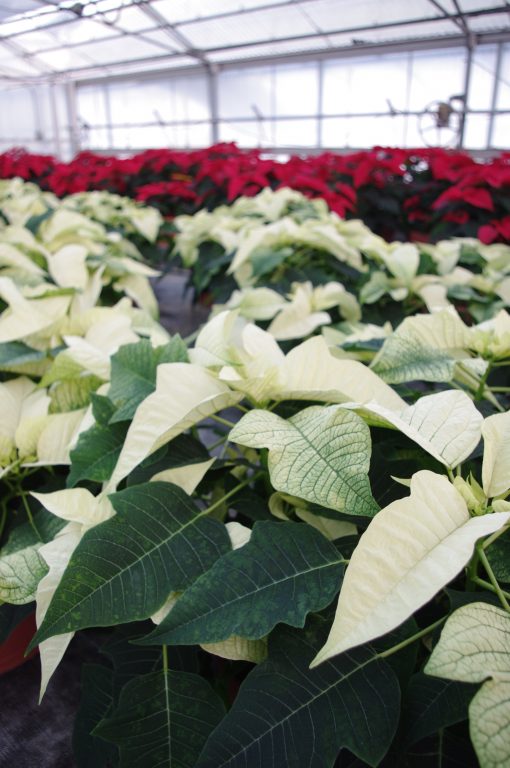
The holiday season is upon us once again, and what holiday decorations would be complete without the addition of colorful poinsettias? The poinsettia (Euphorbia pulcherrima) in its many varieties can bring stunning colors to your holiday season display, but did you ever wonder what the origin of this symbolic holiday plant is, how the colors develop, or how to grow and care for poinsettias yourself?
I. Tropical Origins
Poinsettias are indigenous to Mexico and belong to the Spurge (Euphorbiaceae) family. Its native habitat is at moderate elevations in deciduous tropical forests along the Pacific coast from southern Sinaloa through Chiapas and into Guatemala. It also grows in the interior of Mexico in the hot, seasonally dry forests of Guerrero, Oaxaca, and Chiapas. Poinsettias are actually a shrub or small tree that can grow up to 15 ft. and usually have just one or two stems. The plant was first introduced to the United States in 1825 by Joel Roberts Poinsett, a botanist and the first U.S. Minister to Mexico. Poinsett sent clippings to his home in Greenville, South Carolina, and later the plant was distributed to his horticultural friends, including to John Bartram of the Bartram Botanical Garden in Philadelphia in 1828.
In 1902, Albert Ecke, an immigrant from Germany via Switzerland, began farming in southern California in an area that is now a portion of the City of Los Angeles. In 1906, he moved to Hollywood, California and began raising flowers for market including chrysanthemums, gladioli, and poinsettias. Around the end of that decade, Albert Ecke and his son, Hans, began specializing in growing poinsettias. In 1919, the second son of Albert Ecke, Paul, assumed management of the business after his father and brother’s deaths. In 1963, Paul Ecke, Jr. developed a technique which caused seedlings to branch, resulting in a fuller plant and the flourishing of the poinsettia industry. Today, the Paul Ecke Ranch in Encinatas, California, with additional growing facilities in Guatemala, grows more than 70% of all poinsettias purchased in the U.S. and accounts for about 50% of world-wide sales! Poinsettias are now the best-selling potted plant in the United States and Canada, and their total sales contribute more than 250 million dollars to the U.S. economy at the retail level. In 2015, the business became part of the giant Dutch floriculture company Dummen Orange.

II. Know the Bracts
The colorful part of a poinsettia is not the flower, but rather are the bracts (modified leaves) which surround the small, yellow flowers known as cyathia. The colorful bracts attract insect pollinators to the flowers. In order to grow the colorful bracts of poinsettia, let’s examine how the plant is grown from cuttings.
The cuttings should be ordered early in the year with a planned arrival around the end of June. Check the cuttings for damage, spread on the potting bench, and thoroughly soak the root balls. Using moistened soil and sterile containers, plant the cutting in the center of a loosely filled pot with the plug just slightly covered by soil. Water in thoroughly using a liquid rooting hormone and readjust the soil level in the container to be 3/4″ below the top of the container. Straighten the cutting and assure the rootball depth to be slightly covered with soil to prevent moisture wicking out of the plug. Mist four times daily for the first five days with a two-gallon-per-minute spray nozzle, and check and water the rootball itself for the first week, as sometimes the rootball cube can be dry even if the soil is moist.
Set the temperature to 68 degrees Fahrenheit (F) day and night, and to slow down the growth drop the temperature to 66 degrees F with a minimum night temperature of 64 degrees F. If temperatures are too warm, use a shade cloth and mist multiple times per day to keep temperatures down. Avoid temperatures above 70 degrees F and below 50 degrees F. Provide a 13-2-13 fertilizer at 100 ppm for each watering and increase the fertilizer to150 ppm near the end of September. Fertilization will stop at the beginning of the bract coloring process.
About three weeks after potting when the roots are to the edge of the container and the plants are growing strongly, pinch down to seven nodes from the soil line to encourage a plant with fuller foliage. To ensure a uniform height of your poinsettia crop, count the nodes on the first plant you pinch, and then pinch the remaining at that general height.
The bract coloration process occurs through a change in photo-period, which is a developmental response to the relative lengths of light and dark periods. Poinsettia is a short-day plant which means that in order for the colorful bracts to form, it needs continuous, long dark periods each night. Since poinsettias most often go out from around Thanksgiving through Christmas, plan to have the plants in at least 14 hours of continuous darkness starting around the beginning of October. When it’s not in darkness, the plant should have six to eight hours of bright light daily.

III. Cold Climate Care for a Tropical Plant
I doubt Joel Roberts Poinsett thought the poinsettia would become the cherished holiday flower throughout cold climates that it is today, as he must have known this tropical beauty had specific care requirements. After your in-store purchase, make sure the plant is well-wrapped during transportation (use plastic bags to securely cover the plant), as cold weather does irreparable damage to the bracts and flowers. Poinsettia likes a consistent daytime temperature between 60 and 70 degrees F, and a nighttime temperature around 55 degrees F. High temperatures will shorten the plant’s life. At home, handle the plant carefully as the leaves and branches break easily, and do not place the plant near cold windows, heaters, appliances, or areas of low humidity.
Water the poinsettia so that the soil is moderately moist. This means watering the plant thoroughly when the soil feels dry to the touch, but never let the soil completely dry out and do not let the plant sit in standing water. If your plant is wrapped in foil, punch a hole in the foil so the water can drain into a saucer. Remember, wilted plants will drop their bracts sooner. Do not fertilize a poinsettia when it is in bloom, but if you keep it past the holiday season, fertilize it once a month until late-March.
If keeping a poinsettia year-round appeals to you, prune the plant back to about 8″ in late-March or early-April when the colorful bracts start to fade. Soon, new growth will appear, so continue watering when needed and fertilize every two to three weeks during the spring, summer, and fall. In early-June, transplant the poinsettia into a container two to four inches larger and pinch back shoot tips or prune branches no later than September 1st. To induce bract coloration the next holiday season, follow the photo-period guidelines discussed previously.
IV. Keep It On Point
Poinsettias are beautiful tropical plants that have become a symbol of the holiday season. I hope that when you see poinsettias on display in your home, at the office, or inside buildings around town, you can appreciate the plant’s beauty as Joel Roberts Poinsett did almost two hundred years ago. Now you know and can share with others poinsettia’s rich history, how it’s grown and how its colors develop, and how to provide the care it needs.
If you’re interested in learning more about Euphorbia pulcherrima, please check out the links and references provided.
Clemson University Cooperative Extension Article: Poinsettias by Joey Williamson.
https://www.clemson.edu/extension/hgic/plants/indoor/flowering/hgic1561.html
University of Illinois Cooperative Extension Article: The Poinsettia Pages by Erica D. Seltzer and MaryAnne Spinner.
https://extension.illinois.edu/poinsettia/facts.cfm
References:
Ecke, Jr., and O.A. Matkin. “The Poinsettia Manual, Second Edition”. Paul Ecke Poinsettias. Encinatas California 1976.

All photographs supplied by the author, Cormac N. Griffin.